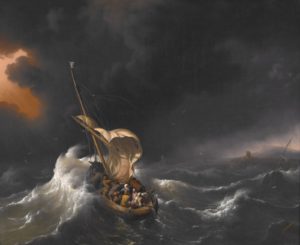Thoughts on Sunday’s Lessons for June 24, 2018

Christ in the Storm on the Sea of Galilee (1695), oil painting by Ludolf Bakhuizen (1630-1708). Indianapolis Museum of Art. (Click image to enlarge.)
First Reading (Track One): 1 Samuel 17: (1a, 4-11, 19-23), 32-49 or 1 Samuel 17:57-18:5, 10-16
The Track One lectionary offers two options this Sunday: The familiar story of the battle between young David and the Philistine giant Goliath; or the less familiar story that follows it, telling of the ominous encounter between King Saul and David after Goliath was slain. Both narratives build toward David’s rise to become King, and jealous Saul’s inclination to kill David before he can assume the crown. We stay with Saul, David and Solomon through August, before our First Testament readings turn to an anthology of wisdom including Proverbs, Job, Esther and Ruth.
First Reading (Track Two): Job 38:1-7,34-41
Even in times of chaos and fear, God remains with us. Surely we are all familiar with the trials of Job, tested by God at the urging of the adversary, retaining his faith in spite of horrifying tests that would break even the strongest. Now, nearing the end of the book, Job, finally gets his wish that God come out of hiding and listen to him. But God, speaking out of a whirlwind with power and might, sets Job in his place with words like thunderbolts: “Where were you when I laid the foundation of the earth? Tell me, if you have understanding.” Job quickly repents; and at the end his fortunes are restored.
Psalm (Track One): Psalm 9:9-20 or Psalm 133
A passage from Psalm 9, accompanying the David and Goliath reading, gives thanks to God who protects the people in time of trouble and oppression; who never forsakes those who seek protection in God’s name. We heard Psalm 133, which goes with the reading about David and Saul, just after Easter. It celebrates the joy of living in unity, using the luxurious metaphor of anointing with fine oil so abundantly that it runs down one’s hair and beard.
Psalm (Track Two): Psalm 107:1-3, 23-32
This beautiful hymn of praise to a God of mercy who protects us in peril sets a pitch-perfect tone for today’s Gospel story about Jesus stilling the storm. The psalmist remembers an event when a storm came upon some travelers whom God had redeemed, who had gone down to the sea in ships. When they cried out to God, the storm gave way to calm. They arrived safely on the shore, and we are called to join them in thanks and praise to a loving God who protects us from peril and delivers us from distress.
Second Reading: 2 Corinthians 6:1-13
The theme of this letter rests on Paul’s effort to reconcile and restore good relations after a period of trouble and anger in the church in Corinth. Paul himself has suffered many things for following in Jesus’ way, he writes: beatings and prison, hunger and sleeplessness, riots and more. If he doesn’t mention storm and shipwreck, we know that Paul endured those trials, too. Through all difficulties, he urges the people to remember that God is with us. Open wide our hearts and accept God’s love.
Gospel: Mark 4:35-41
We continue to follow Jesus and the apostles through his ministry as told by Mark, following him now from the Jewish territory on the west side of the Sea of Galilee across the deep lake to Gentile country on the other side. This sets the scene for the beloved Gospel story of Jesus calming the stormy waters to save the ship. This time, though, pay particular attention to the reactions of the apostles. They are terrified! Jesus doesn’t seem to know that they are in deadly danger. Does he even care that they are scared? And then, after all is calm, they are awestruck by the discovery that Jesus really did have power to still the storm.
What are “Track 1” and “Track 2”?
During the long green season after Pentecost, there are two tracks (or strands) each week for Old Testament readings. Within each track, there is a Psalm chosen to accompany the particular lesson.
The Revised Common Lectionary allows us to make use of either of these tracks, but once a track has been selected, it should be followed through to the end of the Pentecost season, rather than jumping back and forth between the two strands.
For more information from LectionaryPage.net, click here.
